linguistics 2 语音学与音位学
- 格式:pdf
- 大小:4.27 MB
- 文档页数:43


语言学概述这就是综述一下,不过下面提到的名词的都是考过的知识点。
一、定义:什么是语言学?Linguistics is generally defined as the scientific study of language.二、语言学研究的核心(下面的术语要尽量全都认识,不然做题时可能看不懂选项)1、Phonetics 语音学2、Phonology 音位学3、Morphology 形态学4、Syntax 句法学5、Semantics 语义学6、Pragmatics 语用学三、语言(Langue)和言语(Parole)这个考过的。
Parole这个概念是F. de Saussure(索绪尔)提出的。
Langue指语言系统的整体,“所有(语言使用)个体头脑中存储的词语-----形象之总和”,这个整体相对较为稳定;Parole 指某个个体在实际语言使用环境中说出的具体话语,它是随时间和地点变化的一个动态的实体。
四、语言的功能Functions of Language(这个也考过的。
考过the informative function,就是高速公路指示牌的那道题)1、The instrumental function2、The regulatory function3、The heuristic function4、The interactional function5、The personal function6、The imaginative function7、The informative function五、语言的普遍特征Design Features这个也考过的,这五个特征由美国语言学家Charles Hockett提出。
弱弱地说一句:如果真的在临时抱佛脚,那就不要管这五个术语的具体含义了,只要能强行记下来应付考试就是了。
>_<1、Arbitrariness 任意性2、Productivity 多产性3、Duality 双层结构4、Displacement 移位性5、Cultural Transmission 文化传播性六、语音学和音位学(一)语音学Phonetics: the study of the phonic medium of language.1、三大分支(1)Articulatory Phonetics发音语音学(2)Auditory Phonetics 听觉语音学(3)Acoustic Phonetics 声学语音学2、辅音和元音(这个考过的,考过二者的区别)(二)音位学Phonology: aims to discover how speech sounds in a language form pattern and how these sounds are used to convey meaning in linguistic communication.1、三个术语(1)Phone音素(2)Phoneme音位(3)Allophone音位变体2、Suprasegmental Phonology超音段音位(考过的)包括Stress重音、Tone音调、Intonation语调七、形态学Morphology: refers to the study of the internal structure of words, and the rules by which words are formed.(一)两类词汇1、Closed class words封闭性词汇2、Open class words开放性词汇(二)Morpheme词素1、Free morpheme自由词素2、Bound morpheme粘着词素3、Stem词干4、Root词根(三)Word-formation构词法(四)Inflection屈折变化八、句法学Syntax: studies how words are combined to form sentences and the rules that govern the formation of sentences.九、语义学Semantics: is generally considered to be the study of meaning in language.1、Synonymy同义关系2、Polysemy一词多义3、Homophones同音异义&Homogragh同形异义&Complete homonyms同形同音异义4、Hyponymy上下义关系5、Antonymy反义关系6、Analysis of meaning语义分析(1)Componential analysis成分分析(2)Predication analysis述谓分析7、Two-place predicate二向谓词、one-place predicate一向谓词、no-place predicate 零向谓词8、Sense relations between sentences(1)Entailment(2)Presupposition十、语用学1、Pragmatics: the study of how speakers of a language use sentences to effect successful communication. (Or it refers to the study of natural language understanding, and specifically the study of how context influences the interpretation of meanings.)2、区分语义学和语用学的最本质因素是:是否考虑了语言使用过程中的语境。
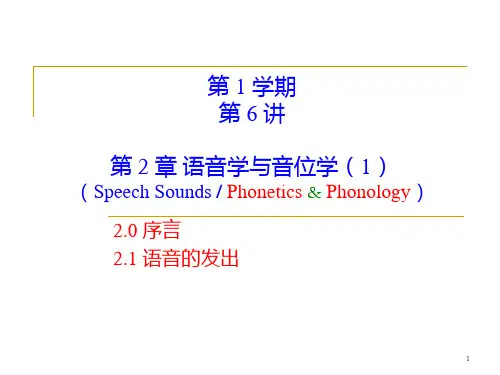

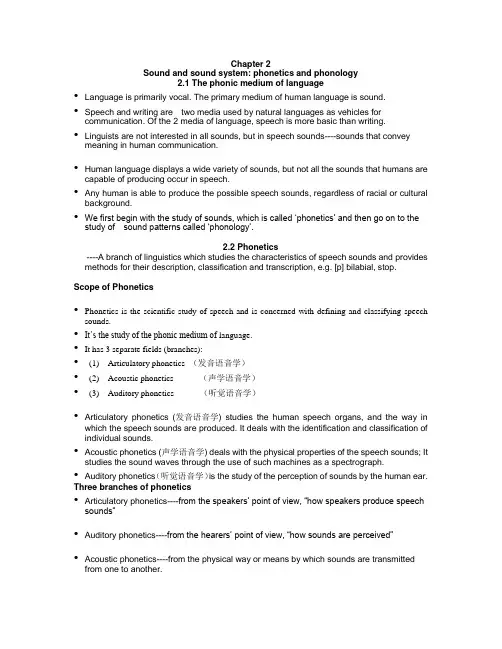
Chapter 2Sound and sound system: phonetics and phonology2.1 The phonic medium of language•Language is primarily vocal. The primary medium of human language is sound. •Speech and writing are two media used by natural languages as vehicles for communication. Of the 2 media of language, speech is more basic than writing. •Linguists are not interested in all sounds, but in speech sounds----sounds that convey meaning in human communication.•Human language displays a wide variety of sounds, but not all the sounds that humans are capable of producing occur in speech.•Any human is able to produce the possible speech sounds, regardless of racial or cultural background.•We first begin with the study of sounds, which is called …phonetics‟ and then go on to the study of sound patterns called …phonology‟.2.2 Phonetics----A branch of linguistics which studies the characteristics of speech sounds and provides methods for their description, classification and transcription, e.g. [p] bilabial, stop.Scope of Phonetics•Phonetics is the scientific study of speech and is concerned with defining and classifying speech sounds.•It’s the study of the phonic medium of language.•It has 3 separate fields (branches):•(1) Articulatory phonetics (发音语音学)•(2) Acoustic phonetics (声学语音学)•(3) Auditory phonetics (听觉语音学)•Articulatory phonetics (发音语音学) studies the human speech organs, and the way in which the speech sounds are produced. It deals with the identification and classification of individual sounds.•Acoustic phonetics (声学语音学) deals with the physical properties of the speech sounds; It studies the sound waves through the use of such machines as a spectrograph. •Auditory phonetics(听觉语音学)is the study of the perception of sounds by the human ear. Three branches of phonetics•Articulatory phonetics----from the speakers‟ point of view, “how speakers produce speech sounds”•Auditory phonetics----from the hearers‟ point of view, “how sounds are perceived”•Acoustic phonetics----from the physical way or means by which sounds are transmitted from one to another.•The 3 branches are closely related to each other. Speech sounds can not be divorced from the organs that articulate them and a sound wave does not exist in isolation from the source that generates it.•All the approaches are indispensable to an understanding of phonetics. Phoneticians are concerned with an objective description of how speech works, measuring speech characteristics as accurately as possible, and providing an account using agreed and understood terminology.Speech organs (vocal organs)The vocal organs consist mainly of the lungs, windpipe, the throat, the nose and the mouth.Speech organs: three important areasThree resonating cavities(1) The pharyngeal cavity--The vocal cords (vocal folds) are either(a) apart (b) close together or (c) totally closed•When the vocal folds are apart, the air can pass through easily and the sound produced is voiceless. Eg: [p] [t] [s]•When they are close together, the air stream causes them to vibrate against each other and the sound produced is voiced. Eg: [b] [d] [z]•When they are totally closed, no air can pass between them and the result is the glottal stop (?). Thus the sound is inaudible, but it has its effect on surrounding segment. In English it is often occurs initially to produce a word like idiot which begins with a vowel. Three resonating cavities(2) The oral cavity--The tongue (the tip, the blade, the front, the back and the root), the softpalate (velum), the hard palate, the uvula, the alveolar ridge, the teeth and the lips.(3) The nasal cavity--The soft palate may be lowered so that the air can go through the nasalcavity, then the sound produced will have a nasal resonance called a nasal.S e g m e n t s(音段)a n d d i v e r g e n c e sSegment—In the production of the word egg,we recognize2 sound segments [e] and [g] for e and g, the other g is silent; lake has 3 sound segments [l] [ei] and [k] for l, a, and k ,the e is silent.•Divergence---The English spelling doesn‟t represent its pronunciation. (异化现象)George Bernard Shaw pointed out the lack of precision in English orthography by spelling fish as ghoti, as gh is pronounced as [f] in enough, o as [i] in women and ti as [∫] in nation.Spelling and SpeechThe diagram of speech organs●Lips●Teeth●Teeth ridge (alveolar)●Hard palate●Soft palate (velum)●Uvula●Tip of tongue●Blade of tongue●Back of tongue●Vocal cords●Pharyngeal cavity●Nasal cavityOrthographic representation of speech sounds---- A standardized and internationally accepted system of phonetic transcription is the International Phonetic Alphabet (IPA). The basic principle of the IPA is using one letter to represent one speech sound.•Broad transcription ---- used in dictionary and textbook for general purpose, without diacritics, e.g. clear [ l ], [ pit ]•Narrow transcription ---- used by phonetician for careful study, with diacritics, e.g. dark [ l ], aspirated [ p ]Narrow and broad transcriptions(严式与宽式音标)•broad transcription ──the system of symbols used generally in dictionaries and language books. ( adequate enough )•narrow transcription ──the phonetic transcription with diacritics (not always necessary). Some major articulatory variables---- dimensions on which speech sounds may vary:•Voicing---- voiced & voiceless•Nasality ---- nasal & non-nasal•Aspiration ----- aspirated & unaspiratedArticulation of SoundsVoice•All languages have both voiceless and voiced sounds contrasting in their phonological systems.•In English, all vowels are voiced, as are some consonants (e.g. /d, b, g, m,…./)•When describing individual sound segments, phoneticians often employ two perspectives to examine how sounds are articulated: manner of articulation and place of articulation. Classification of English speech sounds---- English speech sounds are generally classified into two large categories:•Vowels•ConsonantsNote: The essential difference between these two classes is that in the production of the former the airstream meets with no obstruction of any kind in the throat, the nose or the mouth, while in that of the latter it is somehow obstructed.Classification of consonants---- English consonants may be classified according to two dimensions:The manner of articulation•---The manner or the way in which obstruction is created.•The place of articulation•---The place where obstruction is created.The manner of articulation•stops/plosives: [p], [b], [t], [d], [k], [g];•fricatives: [f], [v], [s], [z], [W], [T], [F], [V], [h];•affricates: [tF], [dV];•liquids: [l](lateral), [r];•nasals: [m], [n], [N];•glides/semivowels: [w], [j].Manner of Articulation (发音方法)classification of English consonants, according to the manner of articulation:stops (6) (塞音): /p, b, t, d, k, g/fricatives (9)(摩擦音): /f, v, s, z, , ❆, ☞, ✞, h/affricatives (6)(破擦音): / ♦☞, ♎✞, tr, dr, ts, dz/liquids (2)(流音): /l, r/nasals (3)(鼻音): /m, n, ☠ /glides (2)(滑动音): /w, j/The place of articulation•bilabial: [p], [b], [ ], [w];•labiodental: [ ], [v];•dental: [ ], [ ];•alveolar: [t], [d], [s], [z], [n], [l], [r];•palatal: [ ], [ ], [ ], [ ], [ ];•velar: [k], [g], [ ];•glottal: [h].Place of Articulation (发音部位)Classification of English consonants, according to the place of articulation:•bilabial (4)(双唇音): /p, b, m, w/•labiodental (2)(唇齿音): /f, v/•dental (2)(舌齿音): / , ❆,/•alveolar (9)(齿齦音): /t, d, n, s, z, l, r, ts, dz/•post-alveolar(2)(齿后音): /tr, dr/•palatal (5)(硬颚音): /☞, ✞, ♦☞, ♎✞, j/•velar (3)(软颚音): /k, g, ☠/•glottal (1)(声门音): /h/The place of articulation●Bilabial;●Labiodental;●Dental or interdental;●Alveolar;●Palatoalveolar;●Palatal;●Velar;●Uvular;●Glottal.The description of English consonantsClassification of vowels---- English vowels can be divided into two large categories:•Monophthongs or pure/single vowels•Diphthongs or gliding vowelsMonophthongs or pure/single vowels----According to which part of the tongue is held highest in the process of production, the vowels can be distinguished as:•front vowels: [ ], [ ], [ ], [ ], [ ]•central vowels: [ ], [ ], [ ];•back vowels: [ ], [ ], [ ], [ ], [ ].VowelsTwo ways of classification:According to the position of the tongue (13):•front vowels (5)(前元音): /i:, i, e, ✌, /•back vowels (5)(后元音): /u:, u, :, , :/•central vowels (3)(中元音): / ☜:, ☜, ✈/According to the openness of the mouth•Close: [ ], [ ], [ ], [ ].•Semi-close: [ ], [ ];•Semi-open: [ ], [ ];•Open: [ ], [ ], [ ], [ ], [ ];The diagram of single vowel classification by applying the two criteria so far mentioned:According to the shape of the lips orthe degree of lip rounding•rounded: [ ], [ ], [ ], [ ];•unrounded: [ ], [ ], [ ], [ ], [ ], [ ], [ ], [ ], [ ], [ ].According to the shape of the lips:•unrounded vowels (8)(非圆唇音)/i:, i, e, ✌ , ☜:, ☜, ✈, :/ •rounded vowels (4) (圆唇音)/u, u:, :, /According to the length of the vowels•long:[ ], [ ], [ ], [ ], [ ]•short: [ ], [ ], [ ], [ ], [ ], [ ], [ ], [ ], [ ].Diphthongs/gliding vowels•[ ], [ ], [ ], [ ], [ ], [ ], [ ], [ ].Exercises: underline the words that begin with a sound as required.• A bilabial consonant: mad sad bad cad pad had lad work• A velar consonant: nod god cod pod rod drink•Labiodental consonant: rat fat sat mat chat vat pat•An alveolar consonant: nick lick sick tick kick quick risk nod• A palato-alveolar consonant: sip ship tip chip lip zip measure ridge• A dental consonant: lie buy thigh thy tie rye• A glide: one war yolk rushUnderline the words that end with a sound as required:• A fricativepay horse tough rice breath push sing wreathe hang cave message• A nasaltrain bang leaf limb• A stopdrill pipe fit crab fog ride laugh rack throughtip•An affricate: rack such ridge boozeUnderline the words that contain the sound as required:• A central vowel:mad lot but boot word• A front vowel:reed pad load fate bit bed cook• A rounded vowel:who he bus her hit true boss bar walk• A back vowel:paid reap fool top good fatherDescribe the underlined consonants according to three dimensions:vd/vl place mannerLetterBrotherSunnyHopperItchingLodgerCallingSingingRobbereitherCharacteristics of English Speech Sounds•Each language has its own sound patterns. English is no exception.•English has many words with the pattern consonant-vowel-consonant, as in the words fit, dig, net, sit, and rid, and many others containing consonants clusters, as in stream, glimpse, task, spray, and shred.•However, no more than three consonants may occur at the beginning of a word. If threeconsonants do occur, the first must be /s/.2.3 Phonology•Phonology studies the patterning of speech sounds, that is, the ways in which speech sounds form systems and patterns in human languages.•音系学(phonology) 研究的是语音的记忆状态和语音使用和组合成语言单位的规律。
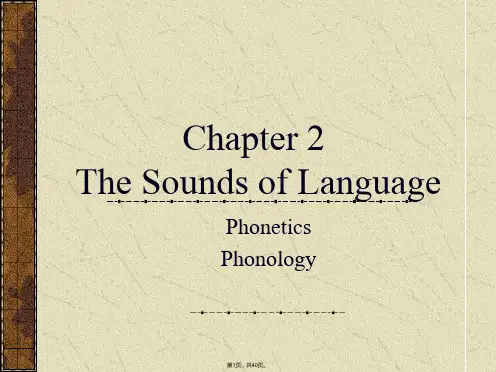
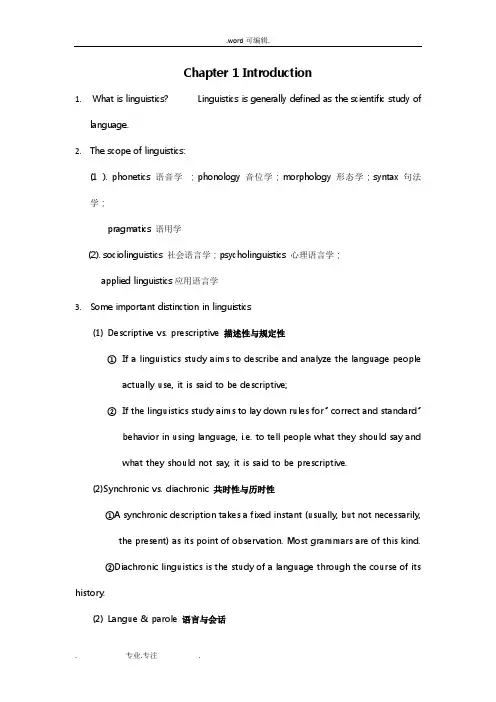
Chapter 1 Introduction1. What is linguistics? Linguistics is generally defined as the scientific study oflanguage.2.The scope of linguistics:(1 ). phonetics 语音学;phonology 音位学;morphology 形态学;syntax 句法学;pragmatics 语用学(2). sociolinguistics 社会语言学;psycholinguistics 心理语言学;applied linguistics应用语言学3.Some important distinction in linguistics(1)Descriptive vs. prescriptive 描述性与规定性①If a linguistics study aims to describe and analyze the language peopleactually use, it is said to be descriptive;②If the linguistics study aims to lay down rules for” correct and standard”behavior in using language, i.e. to tell people what they should say andwhat they should not say, it is said to be prescriptive.(2)Synchronic vs. diachronic 共时性与历时性①A synchronic description takes a fixed instant (usually, but not necessarily,the present) as its point of observation. Most grammars are of this kind.②Diachronic linguistics is the study of a language through the course of its history.(2)Langue & parole 语言与会话①Language refers to the abstract linguistic system shared by all themembers of a speech community.②Parole refers to the realization of language in actual use.(4)Competence and performance 语言能力与语言运用①A language user's unconscious knowledge about the system of rules iscalled his linguistic competence.②Performance refers to the actual use of language in concrete situations.(5)speech and writing 语言与文字Speech and writing are the two major media of communication.(6)traditional grammar and modern linguistic 传统语法与现代语言学4.Definition of language:Language is a system of arbitrary vocal symbols used for human communication.Language is a system, i.e., elements of language are combined according to rules.Language is arbitrary in the sense that there is no intrinsic connection between a linguistics symbol and what the symbol stands.Language is vocal because the primary medium for all languages is sound.The term “human” in the definition is meant to specify that language is human-specific.5.Design features of language6.(1) Arbitrariness 任意性refers to the forms of linguistic signs bear no naturalrelationship to their meaning. (sounds and meanings)(2) Productivity(creativity)能产性Language is productive in that it makes possiblethe construction and interpretation of new signals by its users.(3) duality双重性The property of having two levels of structures, such that units ofthe primary level are composed of elements of the secondary level and each of the two levels has its own principles of organization.(4) displacement移位性Human Languages enable their users to symbolize objects,events and concepts which are not present (in time and space) at moment of communication.(5)cultural transmission 文化传承性7.Functions of language(1) referential (to convey message and information),(2) poetic (to indulge in language for its own sake),(3) emotive (to express attitudes, feelings and emotions),(4) conative (to persuade and influence others through commands and requests),(5) phatic (to establish communion with others)(6) metalingual (to clear up intentions and meanings).①Informative(信息功能): to give information about facts. (ideational)②Interpersonal(人际功能): to establish and maintain social status in asociety.(age, sex, language, background, accent, status)③Performative(施为功能) : language is used to do things, to perform certainactions. (name, promise, apologize, sorry, declare)④. Emotive/Expressive (情感功能): to express feelings and attitudes of thespeaker.⑤Phatic communion(寒暄交流) : to use small and meaningless expressions toestablish a comfortable relationship or maintain social contact between people without any factual content. (health, weather)⑥Recreational function(娱乐): the use of language for sheer joy. (lyrics, poetry)⑦Metalingual function(元语言功能): to talk about language itself.8.9.Chapter 2 Phonology1.Phonetics(语音学)is the study of the phonic medium of language; it isconcerned with all the sounds that occur in the world’s languages. Phonetics studies how speech sounds are produced, transmitted, and perceived.2.Orthographic representation of speech sounds:broad transcription(宽式标音)and narrow transcription(严式标音)A broad transcription(宽式标音)is the transcription with letter-symbols only.A narrow transcription(严式标音)is a transcription with letter symbols togetherwith diacritics.3.Phonology(音位学)is the study of the sound patterns and sound systems oflanguages.4.The differences between phonetics and phonology:(语音的正字表征)①Both are concerned with the same aspect of language----the speech sounds. Butthey differ in their approach and focus.②Phonetics is of general nature; it is interested in all the speech sounds used in allhuman languages; it aims to answer questions like: how they are produced, how they differ from each other, what phonetic features they have, how they can be classified, etc.③Phonology aims to discover how speech sounds in a language form patterns and how these sounds are used to convey meaning in linguistic communication.5.Phone(音素), phoneme(音位), allophone(音位变体)A phone---- a phonetic unit or segment. The speech sounds we hear and produceduring linguistic communication are all phones.A phoneme---- is a phonological unit; it is a unit of distinctive value; an abstract unit,not a particular sound, but it is represented by a certain phone in certain phonetic context6.Phonemic contrast, complementary distribution and minimal pair.(音位对立,互补分布,最小对立体)7.Some rules of phonology(音位学规则)Sequential rules 序列规则Assimilation rule 同化规则Deletion rule省略规则8.Suprasegmental features (超音段特征):stress重音,tone音调,intonation语调9.10.Chapter 3 Morphology1.Classification of words(1)Variable vs. invariable words:可变词类和不可变词类Variable words: One could find ordered and regular series of grammatically different word forms; on the other hand, part of the word remains constant follow, follows, following, followed; mat, matsInvariable words: those words such as since, when, seldom, through, hello. They do not have inflective endings.(2)Grammatical words vs. lexical words:语法词类和词汇词类Grammatical words: express grammatical meanings, such as conjunctions, prepositions, articles, pronounsLexical words: have lexical meanings, those which refer to substance, action and quality, such as nouns, verbs, adjectives, and adverbs.(3)Closed-class words vs. open-class words:封闭词类和开放词类Closed-class: a word whose membership is fixed or limited. New members are not regularly added. Pronouns, prepositions, conjunctions, articles, etc.Open-class: A word whose membership is in principle infinite or unlimited. Nouns, verbs, adjectives, adverbsGrammatical---lexical words closed-class---open-class words2.Morphere(词素):the minimal meaningful unit of language.3.Linguistics use the term morphology to refer the part of the grammar that isconcerned with word formation and word structure.4.Free morpheme & bound morpheme(自由语素和黏着语素)A morpheme which can be a word by itself is called a free morpheme; a morphemethat must be attached to another one is a bound morpheme.5.The variant forms of a morpheme are called its allomorphs.(词素变体)6.Inflectional affix & derivational affix(屈折词缀和派生词缀)pound: those words that consist of more than one free morphemes, the way tojoin two separate words to produce a single form.In compounds, the lexical morphemes can be of different word classes.pounds can be further divided into two kinds:the endocentric compound (向心复合词) the exocentric compound(离心复合词)9.Endocentric: one element serves as the head, the relationship of “a kind of”; egself-control: a kind of control armchair: a kind of chair10.Exocentric: there is no head, so not a relationship of “a kind of something”, egscarecrow: not a kind of crow breakneck: not a kind of neck11.Chapter 4 Syntax1.What is Syntax (句法)?Syntax is the study of the rules governing the ways different constituents are combined to form sentences. 句法就是研究语言的不同成分组成句子的规则2.Syntactic relations can be analyzed into three kinds:relations of position 位置关系relations of substitutability 替代关系relations of co-occurrence 同现关系3.4.5.Chapter 5 Semantics1.What is Semantics?Semantics is the study of the meaning of words, phrases and sentences.语义学是研究单词、短语和句子的意义的学科2.The conceptualist view①The conceptualist view holds that there is no direct link between a linguistic formand what it refers to (i.e. between language and the real world); rather, in the interpretation of meaning they are linked through the mediation of concepts in the mind.②This is illustrated by the classic semantic triangle or triangle of significancesuggested by Ogden and Richard.Thought/reference/conceptSymbol/form referencentword/phrase/sentence③The symbol or form refers to the linguistic elements (words andphrases);The referent refers to the object in the world of experience;Thought or reference refers to concept.The symbol or a word signifies things by virtue of the concept associated withthe form of the word in the minds of the speaker; and the concept looked atfrom this point of view is the meaning of the word.3.The contextualismMeaning should be studied in terms of situation, use, context—elements closely linked with language behavior. Two types of contexts are recognized:Situational context: spatiotemporal situationLinguistic context: the probability of a word’s co-occurrence or collocation.4.BehaviorismBehaviorists attempted to define meaning as “the situation in which the speaker utters it and the response it calls forth in the hearer”.5.Lexical meaningSense and reference are both concerned with the study of word meaning. They are two related but different aspects of meaning.Sense---- is concerned with the inherent meaning of the linguistic form. It is the collection of all the features of the linguistic form; it is abstract and de-contextualized.It is the aspect of meaning dictionary compilers are interested in.Reference----what a linguistic form refers to in the real, physical world; it deals with the relationship between the linguistic element and the non-linguistic world of experience.6.Major sense relations(1)Synonymy 同义词①Dialect synonymy 方言同义词②Stylistic synonymy 文体同义词③Synonyms that differ in their emotive or evaluative meaning④Collocational synonyms⑤Semantically different synonyms(2)Antonym 反义词①Gradable antonyms 等级反义词②Complementary antonyms 互补反义词③Relational opposites 关系反义词(3)Polysemy 一词多义(4)Homonymy 同形异义词(5)Hyponymy 上下义关系①Superordinate 上义词②Hyponyms下义词ponential analysis 成分分析法——a way of analyze lexical meaningIt is a way proposed by the structural semanticists to analyze word meaning.The.word可编辑.approach is based on the belief that the meaning of a word can be dissected into meaning components, called semantic features.8.. 专业.专注.。
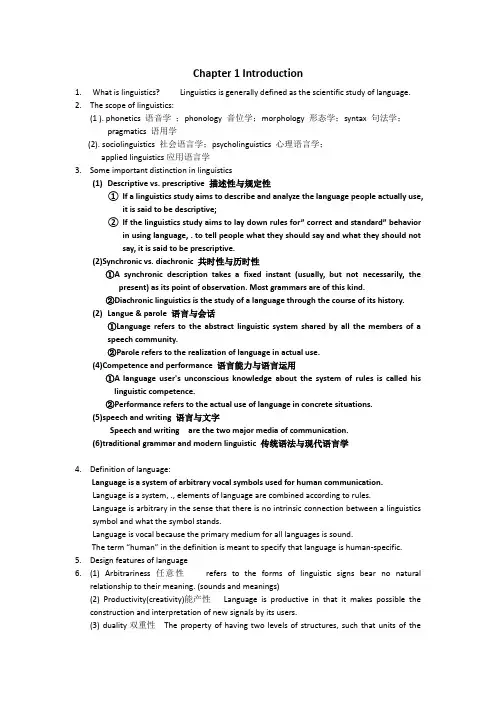
Chapter 1 Introduction1. What is linguistics? Linguistics is generally defined as the scientific study of language.2.The scope of linguistics:(1 ). phonetics 语音学;phonology 音位学;morphology 形态学;syntax 句法学;pragmatics 语用学(2). sociolinguistics 社会语言学;psycholinguistics 心理语言学;applied linguistics应用语言学3.Some important distinction in linguistics(1)Descriptive vs. prescriptive 描述性与规定性①If a linguistics study aims to describe and analyze the language people actually use,it is said to be descriptive;②If the linguistics study aims to lay down rules for” correct and standard” behaviorin using language, . to tell people what they should say and what they should notsay, it is said to be prescriptive.(2)Synchronic vs. diachronic 共时性与历时性①A synchronic description takes a fixed instant (usually, but not necessarily, thepresent) as its point of observation. Most grammars are of this kind.②Diachronic linguistics is the study of a language through the course of its history.(2)Langue & parole 语言与会话①Language refers to the abstract linguistic system shared by all the members of aspeech community.②Parole refers to the realization of language in actual use.(4)Competence and performance 语言能力与语言运用①A language user's unconscious knowledge about the system of rules is called hislinguistic competence.②Performance refers to the actual use of language in concrete situations.(5)speech and writing 语言与文字Speech and writing are the two major media of communication.(6)traditional grammar and modern linguistic 传统语法与现代语言学4.Definition of language:Language is a system of arbitrary vocal symbols used for human communication.Language is a system, ., elements of language are combined according to rules.Language is arbitrary in the sense that there is no intrinsic connection between a linguistics symbol and what the symbol stands.Language is vocal because the primary medium for all languages is sound.The term “human” in the definition is meant to specify that language is human-specific.5.Design features of language6.(1) Arbitrariness 任意性refers to the forms of linguistic signs bear no naturalrelationship to their meaning. (sounds and meanings)(2) Productivity(creativity)能产性Language is productive in that it makes possible theconstruction and interpretation of new signals by its users.(3) duality双重性The property of having two levels of structures, such that units of theprimary level are composed of elements of the secondary level and each of the two levels has its own principles of organization.(4) displacement移位性Human Languages enable their users to symbolize objects, eventsand concepts which are not present (in time and space) at moment of communication.(5)cultural transmission 文化传承性7.Functions of language(1) referential (to convey message and information),(2) poetic (to indulge in language for its own sake),(3) emotive (to express attitudes, feelings and emotions),(4) conative (to persuade and influence others through commands and requests),(5) phatic (to establish communion with others)(6) metalingual (to clear up intentions and meanings).①Informative(信息功能): to give information about facts. (ideational)②Interpersonal(人际功能): to establish and maintain social status in a society.(age,sex, language, background, accent, status)③Performative(施为功能) : language is used to do things, to perform certain actions.(name, promise, apologize, sorry, declare)④. Emotive/Expressive (情感功能): to express feelings and attitudes of the speaker.⑤Phatic communion(寒暄交流) : to use small and meaningless expressions to establisha comfortable relationship or maintain social contact between people without any factualcontent. (health, weather)⑥Recreational function(娱乐): the use of language for sheer joy. (lyrics, poetry)⑦Metalingual function(元语言功能): to talk about language itself.8.9.Chapter 2 Phonology1.Phonetics(语音学)is the study of the phonic medium of language; it is concerned with allthe sounds that occur in the world’s languages.Phonetics studies how speech sounds are produced, transmitted, and perceived.2.Orthographic representation of speech sounds:broad transcription(宽式标音)and narrow transcription(严式标音)A broad transcription(宽式标音)is the transcription with letter-symbols only.A narrow transcription(严式标音)is a transcription with letter symbols together withdiacritics.3.Phonology(音位学)is the study of the sound patterns and sound systems of languages.4.The differences between phonetics and phonology:(语音的正字表征)①Both are concerned with the same aspect of language----the speech sounds. But theydiffer in their approach and focus.②Phonetics is of general nature; it is interested in all the speech sounds used in all humanlanguages; it aims to answer questions like: how they are produced, how they differ fromeach other, what phonetic features they have, how they can be classified, etc.③Phonology aims to discover how speech sounds in a language form patterns and how these sounds are used to convey meaning in linguistic communication.5.Phone(音素), phoneme(音位), allophone(音位变体)A phone---- a phonetic unit or segment. The speech sounds we hear and produce duringlinguistic communication are all phones.A phoneme---- is a phonological unit; it is a unit of distinctive value; an abstract unit, not aparticular sound, but it is represented by a certain phone in certain phonetic context6.Phonemic contrast, complementary distribution and minimal pair.(音位对立,互补分布,最小对立体)7.Some rules of phonology(音位学规则)Sequential rules 序列规则Assimilation rule 同化规则Deletion rule省略规则8.Suprasegmental features (超音段特征):stress重音,tone音调,intonation语调9.10.Chapter 3 Morphology1.Classification of words(1)Variable vs. invariable words:可变词类和不可变词类Variable words: One could find ordered and regular series of grammatically different word forms; on the other hand, part of the word remains constant follow, follows, following, followed; mat, matsInvariable words: those words such as since, when, seldom, through, hello. They do not have inflective endings.(2)Grammatical words vs. lexical words:语法词类和词汇词类Grammatical words: express grammatical meanings, such as conjunctions, prepositions, articles, pronounsLexical words: have lexical meanings, those which refer to substance, action and quality, such as nouns, verbs, adjectives, and adverbs.(3)Closed-class words vs. open-class words:封闭词类和开放词类Closed-class: a word whose membership is fixed or limited. New members are not regularly added. Pronouns, prepositions, conjunctions, articles, etc.Open-class: A word whose membership is in principle infinite or unlimited. Nouns, verbs, adjectives, adverbsGrammatical---lexical words closed-class---open-class words2.Morphere(词素):the minimal meaningful unit of language.3.Linguistics use the term morphology to refer the part of the grammar that is concerned withword formation and word structure.4.Free morpheme & bound morpheme(自由语素和黏着语素)A morpheme which can be a word by itself is called a free morpheme; a morpheme thatmust be attached to another one is a bound morpheme.5.The variant forms of a morpheme are called its allomorphs.(词素变体)6.Inflectional affix & derivational affix(屈折词缀和派生词缀)pound: those words that consist of more than one free morphemes, the way to join twoseparate words to produce a single form.In compounds, the lexical morphemes can be of different word classes.pounds can be further divided into two kinds:the endocentric compound (向心复合词) the exocentric compound(离心复合词)9.Endocentric: one element serves as the head, the relationship of “a kind of”; eg self-control:a kind of control armchair: a kind of chair10.Exocentric: there is no head, so not a relationship of “a kind of something”, egscarecrow: not a kind of crow breakneck: not a kind of neck11.Chapter 4 Syntax1.What is Syntax (句法)?Syntax is the study of the rules governing the ways different constituents are combined to form sentences. 句法就是研究语言的不同成分组成句子的规则2.Syntactic relations can be analyzed into three kinds:relations of position 位置关系relations of substitutability 替代关系relations of co-occurrence 同现关系3.4.5.Chapter 5 Semantics1.What is Semantics?Semantics is the study of the meaning of words, phrases and sentences.语义学是研究单词、短语和句子的意义的学科2.The conceptualist view①The conceptualist view holds that there is no direct link between a linguistic form andwhat it refers to . between language and the real world); rather, in the interpretation of meaning they are linked through the mediation of concepts in the mind.②This is illustrated by the classic semantic triangle or triangle of significance suggested byOgden and Richard.Thought/reference/conceptSymbol/form referencentword/phrase/sentence③The symbol or form refers to the linguistic elements (words and phrases);Thereferent refers to the object in the world of experience;Thought or reference refers to concept.The symbol or a word signifies things by virtue of the concept associated with theform of the word in the minds of the speaker; and the concept looked at from thispoint of view is the meaning of the word.3.The contextualismMeaning should be studied in terms of situation, use, context—elements closely linked with language behavior. Two types of contexts are recognized:Situational context: spatiotemporal situationLinguistic context: the probability of a word’s co-occurrence or collocation.4.BehaviorismBehaviorists attempted to define meaning as “the situation in which the speaker utters it and the response it calls forth in the hearer”.5.Lexical meaningSense and reference are both concerned with the study of word meaning. They are two related but different aspects of meaning.Sense---- is concerned with the inherent meaning of the linguistic form. It is the collection of all the features of the linguistic form; it is abstract and de-contextualized. It is the aspect of meaning dictionary compilers are interested in.Reference----what a linguistic form refers to in the real, physical world; it deals with the relationship between the linguistic element and the non-linguistic world of experience.6.Major sense relations(1)Synonymy 同义词①Dialect synonymy 方言同义词②Stylistic synonymy 文体同义词③Synonyms that differ in their emotive or evaluative meaning④Collocational synonyms⑤Semantically different synonyms(2)Antonym 反义词①Gradable antonyms 等级反义词②Complementary antonyms 互补反义词③Relational opposites 关系反义词(3)Polysemy 一词多义(4)Homonymy 同形异义词(5)Hyponymy 上下义关系①Superordinate 上义词②Hyponyms下义词ponential analysis 成分分析法——a way of analyze lexical meaningIt is a way proposed by the structural semanticists to analyze word meaning.The approach is based on the belief that the meaning of a word can be dissected into meaning components, called semantic features.8.。
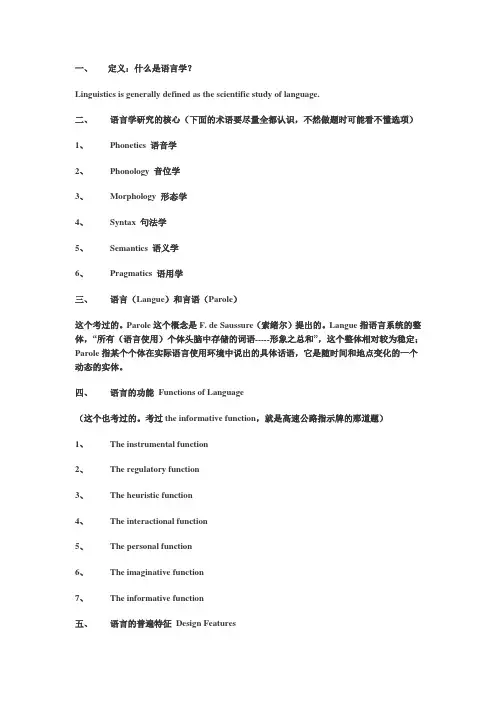
一、定义:什么是语言学?Linguistics is generally defined as the scientific study of language.二、语言学研究的核心(下面的术语要尽量全都认识,不然做题时可能看不懂选项)1、Phonetics 语音学2、Phonology 音位学3、Morphology 形态学4、Syntax 句法学5、Semantics 语义学6、Pragmatics 语用学三、语言(Langue)和言语(Parole)这个考过的。
Parole这个概念是F. de Saussure(索绪尔)提出的。
Langue指语言系统的整体,“所有(语言使用)个体头脑中存储的词语-----形象之总和”,这个整体相对较为稳定;Parole指某个个体在实际语言使用环境中说出的具体话语,它是随时间和地点变化的一个动态的实体。
四、语言的功能Functions of Language(这个也考过的。
考过the informative function,就是高速公路指示牌的那道题)1、The instrumental function2、The regulatory function3、The heuristic function4、The interactional function5、The personal function6、The imaginative function7、The informative function五、语言的普遍特征Design Features这个也考过的,这五个特征由美国语言学家Charles Hockett提出。
弱弱地说一句:如果真的在临时抱佛脚,那就不要管这五个术语的具体含义了,只要能强行记下来应付考试就是了。
>_<1、Arbitrariness 任意性2、Productivity 多产性3、Duality 双层结构4、Displacement 移位性5、Cultural Transmission 文化传播性六、语音学和音位学(一)语音学Phonetics: the study of the phonic medium of language.1、三大分支(1)Articulatory Phonetics发音语音学(2)Auditory Phonetics 听觉语音学(3)Acoustic Phonetics 声学语音学2、辅音和元音(这个考过的,考过二者的区别)(二)音位学Phonology: aims to discover how speech sounds in a language form pattern and how these sounds are used to convey meaning in linguistic communication.1、三个术语(1)Phone音素(2)Phoneme音位(3)Allophone音位变体2、Suprasegmental Phonology超音段音位(考过的)包括Stress重音、Tone音调、Intonation语调七、形态学Morphology: refers to the study of the internal structure of words, and the rules by which words are formed.(一)两类词汇1、Closed class words封闭性词汇2、Open class words开放性词汇(二)Morpheme词素1、Free morpheme自由词素2、Bound morpheme粘着词素3、Stem词干4、Root词根(三)Word-formation构词法(四)Inflection屈折变化八、句法学Syntax: studies how words are combined to form sentences and the rules that govern the formation of sentences.九、语义学Semantics: is generally considered to be the study of meaning in language.1、Synonymy同义关系2、Polysemy一词多义3、Homophones同音异义&Homogragh同形异义&Complete homonyms同形同音异义4、Hyponymy上下义关系5、Antonymy反义关系6、Analysis of meaning语义分析(1)Componential analysis成分分析(2)Predication analysis述谓分析7、 Two-place predicate二向谓词、one-place predicate一向谓词、no-place predicate 零向谓词8、 Sense relations between sentences(1)Entailment(2)Presupposition十、语用学1、Pragmatics: the study of how speakers of a language use sentences to effect successful communication. (Or it refers to the study of natural language understanding, and specifically the study of how context influences the interpretation of meanings.)2、区分语义学和语用学的最本质因素是:是否考虑了语言使用过程中的语境。
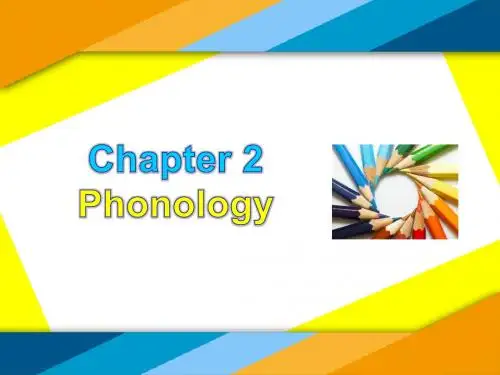
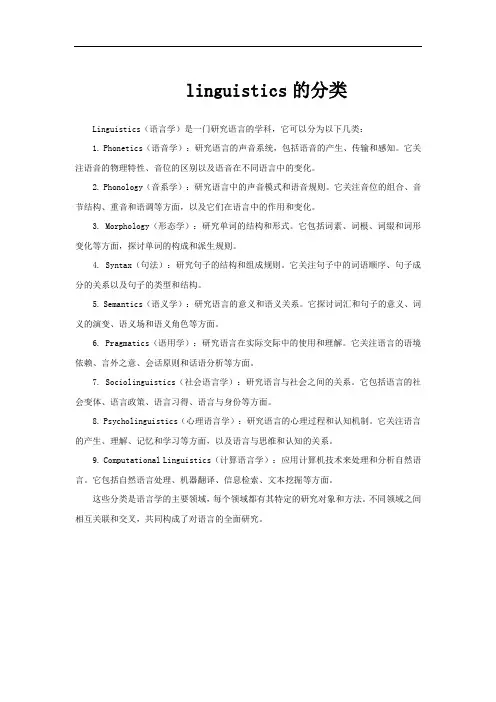
linguistics的分类Linguistics(语言学)是一门研究语言的学科,它可以分为以下几类:1. Phonetics(语音学):研究语言的声音系统,包括语音的产生、传输和感知。
它关注语音的物理特性、音位的区别以及语音在不同语言中的变化。
2. Phonology(音系学):研究语言中的声音模式和语音规则。
它关注音位的组合、音节结构、重音和语调等方面,以及它们在语言中的作用和变化。
3. Morphology(形态学):研究单词的结构和形式。
它包括词素、词根、词缀和词形变化等方面,探讨单词的构成和派生规则。
4. Syntax(句法):研究句子的结构和组成规则。
它关注句子中的词语顺序、句子成分的关系以及句子的类型和结构。
5. Semantics(语义学):研究语言的意义和语义关系。
它探讨词汇和句子的意义、词义的演变、语义场和语义角色等方面。
6. Pragmatics(语用学):研究语言在实际交际中的使用和理解。
它关注语言的语境依赖、言外之意、会话原则和话语分析等方面。
7. Sociolinguistics(社会语言学):研究语言与社会之间的关系。
它包括语言的社会变体、语言政策、语言习得、语言与身份等方面。
8. Psycholinguistics(心理语言学):研究语言的心理过程和认知机制。
它关注语言的产生、理解、记忆和学习等方面,以及语言与思维和认知的关系。
9. Computational Linguistics(计算语言学):应用计算机技术来处理和分析自然语言。
它包括自然语言处理、机器翻译、信息检索、文本挖掘等方面。
这些分类是语言学的主要领域,每个领域都有其特定的研究对象和方法。
不同领域之间相互关联和交叉,共同构成了对语言的全面研究。
第一节语言的本质一、语言的普遍特征(Design Features)1. 任意性Arbitratriness:shu 和Tree都能表示“树”这一概念;同样的声音,各国不同的表达方式2. 层结构Duality:语言由声音结构和意义结构组成(the structure of sounds and meaning)3. 多产性productive:语言可以理解并创造无限数量的新句子,是由双层结构造成的结果(Understand and create unlimited number with sentences)4. 移位性Displacemennt:可以表达许多不在场的东西,如过去的经历、将来可能发生的事情,或者表达根本不存在的东西等5. 文化传播性Cultural Transmission:语言需要后天在特定文化环境中掌握二、语言的功能(Functions of Language)1. 传达信息功能Informative:最主要功能The main function2. 人际功能Interpersonal:人类在社会中建立并维持各自地位的功能establish and maintain their identity3. 行事功能performative:现实应用——判刑、咒语、为船命名等Judge,naming,and curses4. 表情功能Emotive:表达强烈情感的语言,如感叹词/句exclamatory expressions5. 寒暄功能Phatic:应酬话phatic language,比如“吃了没?”“天儿真好啊!” 等等6. 元语言功能Metalingual:用语言来谈论、改变语言本身,如book可以指现实中的书也可以用“book这个词来表达作为语言单位的“书”三、语言学的分支1. 核心语言学Core linguistic(1)语音学Phonetics:关注语音的产生、传播和接受过程,着重考察人类语言中的单音。
第一章:Linguistics is generally defined as the scientific study of language.(语言学普遍被定义为对语言进行的科学研究.)Language is a system of arbitrary vocal symbols used for human communication.(语言是用于人类交际目的的一套任意的有声符号系统.)The scope of linguistics(语言学的研究视野):1.phonetics(语音学)2.phonology(音位学)3.morphology(形态学)4.syntax(句法学)5.semantics(语义学)6.pragmatics(语用学)Some important distinctions in linguistics(语言学中的一些重要区分):1.prescriptive & descriptive(规定性与描写性)2.synchronic & diachronic(共时性与历时性)3.speech and writing(言语与文字)nguage and parole(语言与言语)petence and performance(语言能力与语言运用)6.traditional grammar and modern linguistics(传统语法与现代语言学)The difference between traditional grammar and modern linguistics(传统语法与现代语言学之间的异同点):1.Linguistics is descriptive while traditional grammar is prescriptive.2.Modern linguistics regards the spoken language as primary, not the written.3.Modern linguistics differs from traditional grammar also in that it does not force languages into a Latin-based framework.The design/defining features of human language(语言的甄别性特征):1.Arbitrariness(语言的武断性/任意性)2. Productivity(语言的创造性)3.Duality(语言的二重性)4.Displacement(语言的移位性)5.Cultural transmission(语言的文化传递性)第二章:Phonetics(语音学) is defined as the study of the phonic medium of language; it is concerned with all the sounds th at occur in the world’s languages.(语音学指的是对语言的语音媒介进行的研究)Three branches of phonetics:1.Articulatory phonetics(发音语音学)—from the speakers’ point of view,”how speakers produce speech sounds.”2.Auditory phonetics(听觉语音学)—from the hearer’s point of view,”how sounds are perceived.”3.Acoustic phonetics(声学语音学)—from the physical way or means by which sounds are transmitted from one to another.Speech organs(发音器官):three important areas:1.the pharyngeal cavity(咽腔)----the throat2.the oral cavity(口腔)----the mouth3.the nasal cavity(鼻腔)----the noseThe diagram of speech organs:1.lips(唇)2.teeth(齿)3.teeth ridge(alveolus)(牙齿/龈)4.hard palate(硬腭)5.soft palate(velum)(软腭)6.uvula(小舌)7.tip of tongue(舌尖)8.blade of tongue(舌面)9.back of tongue(舌后) 10.vocal cords(声带) 11.pharyngeal cavity(咽腔) 12.nasal cavity(鼻腔)Orthographic representation of speech sounds(语音的正字法表征):1. A standardized and internationally accepted system of phonetic transcription is the International Phonetic Alphabet(IPA)国际音标.2. The basic principle of the IPA is using one letter to represent one speech sound.(其基本原则是一个字母待变一个音.)Braod transcription(宽式标音)----used in dictionary and textbook for general purpose, without diacritics.Narrow transcription(严式标音)----used by phonetician for careful study, with diacritics.Classification of English consonants(辅音的分类):Ⅰ、in terms of manner of articulation(发音方式):1.stops(闭塞音)/plosives(爆破音)2.fricatives(摩擦音)3.affricates(塞擦音)4.liquids(流音)5.nasals(鼻音)6.glides(滑音)/semivowels(半元音)Ⅱ、in terms of place of articulation(发音部位):1.bilabial(双唇音)biodental(唇齿音)3.dental(齿音)4.alveolar(齿龈音)5.palatal(腭音)6.velar(软腭音)7.glottal(喉音)Classification of English vowels(元音的分类):1.monophthongs or pure/single vowels(单元音)2.diphthongs(双元音)Phonology(音位学) studies the patterning of speech sounds, that is , the ways in which speech sounds forms systems and patterns in human languages.(音位学研究的是语音如何组合在一起并在交流中传达意义.)Phone(音素):a phone is a phonetic unit or segment. The speech sounds we hear and produce during linguistic communication are all phones.(音素是一个语音单位或者说语音段.我们在语言交际中听到的、发出的语音都是音素。